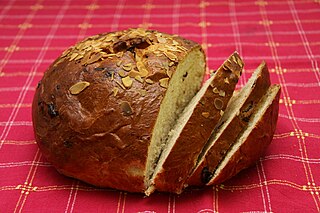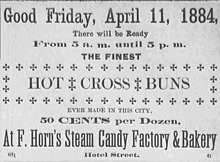
Hungarian or Magyar cuisine is the cuisine characteristic of the nation of Hungary, and its primary ethnic group, the Magyars. Hungarian cuisine has been described as being the spiciest cuisine in Europe. This can largely be attributed to the use of their piquant native spice, Hungarian paprika, in many of their dishes. A mild version of the spice, Hungarian sweet paprika, is commonly used as an alternative. Traditional Hungarian dishes are primarily based on meats, seasonal vegetables, fruits, bread, and dairy products.

Finnish cuisine is notable for generally combining traditional country fare and haute cuisine with contemporary continental-style cooking. Fish and meat play a prominent role in traditional Finnish dishes in some parts of the country, while the dishes elsewhere have traditionally included various vegetables and mushrooms. Evacuees from Karelia contributed to foods in other parts of Finland in the aftermath of the Continuation War.
A spiced bun is a sweet bun to which spices were added during the baking process. Common examples are the hot cross bun and the Jamaican spiced bun.

A semla, vastlakukkel, laskiaispulla, Swedish eclair, fastlagsbulle/fastelavnsbolle or vēja kūkas is a traditional sweet roll made in various forms in Sweden, Finland, Norway, Denmark, the Faroe Islands, Iceland, Estonia, and Latvia, associated with Lent and especially Shrove Tuesday in most countries, Shrove Monday in Denmark, parts of southern Sweden, Iceland and Faroe Islands or Sunday of Fastelavn in Norway. In Sweden it is most commonly known as just semla, but is also known as fettisdagsbulle, lit. 'Fat Tuesday bun' or 'Shrove Tuesday bun'. In the southern parts of Sweden, as well as in Swedish-speaking Finland, it is known as fastlagsbulle. In Poland it is known as ptyś. In Estonia it is called vastlakukkel. In Norway and Denmark it is called fastelavnsbolle. In Iceland, it is known as a bolla and served on Bolludagur. In Faroe Islands it is called Føstulávintsbolli, and is served on Føstulávintsmánadagur. In Latvia, it is called vēja kūkas. Semla served in a bowl of hot milk is hetvägg.
Jamaican cuisine includes a mixture of cooking techniques, flavours and spices influenced by Amerindian, West African, Irish, English, French, Portuguese, Spanish, Indian, Chinese and Middle Eastern people who have inhabited the island. It is also influenced by the crops introduced into the island from tropical Southeast Asia, many of which are now grown locally. A wide variety of seafood, tropical fruits and meats are available.

Simnel cake is a fruitcake widely eaten in England, Ireland and other countries with patterns of migration from them, associated with Lent and Easter. It is distinguished by layers of almond paste or marzipan, typically one in the middle and one on top, and a set of eleven balls made of the same paste. It was originally made for the fourth Sunday in Lent, also known as Laetare Sunday, the Refreshment Sunday of Lent, Mothering Sunday, the Sunday of the Five Loaves, or Simnel Sunday; named after the cake. In the United Kingdom it is now commonly associated with Mothering Sunday and Easter Sunday.
Hot Cross Buns was an English street cry, later perpetuated as a nursery rhyme and an aid in musical education. It refers to the spiced English confection known as a hot cross bun, which is associated with the end of Lent and is eaten on Good Friday in various countries. The song has a Roud Folk Song Index number of 13029.

In many European countries, particularly in Central and Eastern Europe, there are various traditions surrounding the use of bread during the Easter holidays. Traditionally the practice of eating Easter bread or sweetened "communion" bread traces its origin back to Byzantium, Eastern Catholicism and the Orthodox Christian church. The recipe for sweetened or "honey-leavened" bread may date back as far as the Homeric Greek period based on anecdotal evidence from classical texts.

Monkey bread is a soft, sweet, sticky pastry served in the United States for breakfast or as a treat. It consists of pieces of soft baked dough sprinkled with cinnamon. Often a midmorning/breakfast food. It is often served at fairs and festivals.

Coco bread is a Jamaican bread eaten on the island and in other areas of the Caribbean. The bread contains milk or coconut milk and is starchy and slightly sweet in taste.
Bermudian cuisine reflects a rich and diverse history and heritage blending British and Portuguese cuisine with preparations of local seafood species, particularly wahoo and rockfish. Traditional dishes include codfish and potatoes served either with an add on of hard boiled egg and butter or olive oil sauce with a banana or in the Portuguese style with tomato-onion sauce, peas and rice. Hoppin' John, pawpaw casserole and fish chowder are also specialties of Bermuda. As most ingredients used in Bermuda's cuisine are imported, local dishes are offered with a global blend, with fish as the major ingredient, in any food eaten at any time.

Lent is the solemn Christian religious observance in the liturgical year commemorating the 40 days Jesus spent fasting in the desert and enduring temptation by Satan, according to the Gospels of Matthew, Mark and Luke, before beginning his public ministry. Lent is usually observed in the Catholic, Lutheran, Moravian, Anglican, United Protestant and Orthodox Christian traditions, among others. Some Anabaptist, Baptist, Methodist, Reformed, and nondenominational Christian churches also observe Lent, although many churches in these traditions do not.

Easter traditions are customs and practices that are followed in various cultures and communities around the world to celebrate Easter, which is the central feast in Christianity, commemorating the resurrection of Jesus. The Easter season is seen as a time of celebration and feasting, in contrast to the antecedent season of Lent, which is a time of penitence and fasting.
Dan Lepard is an Australian baker, food writer, photographer, television presenter and celebrity chef. He was previously a fashion photographer working for Italian Vogue before changing careers age 27, and is today known for reconciling historical methods with innovation in baking.

The holiday of Easter is associated with various Easter customs and foodways. Preparing, coloring, and decorating Easter eggs is one such popular tradition. Lamb is eaten in many countries, mirroring the Jewish Passover meal.

A Heißwecke, HICE-veck-ə,, also called a Heißewecke or Hedewig, is a traditional type of currant bun within the German-speaking region of Europe that goes back to at least to the Late Middle Ages. In North and Northwest Germany it is eaten before the beginning of the pre-Easter fasting period known as Lent, especially from Rose Monday (Rosenmontag) to Ash Wednesday (Aschermittwoch). It is a sweet bread roll made with milk and wheat flour that is eaten hot, hence the name: Heißwecken literally means "hot rolls". Heißwecken are predominantly eaten in the area influenced by the Hanseatic League i.e. most of northern Europe from what is now the Netherlands to Poland and the Baltic Sea coast. It has numerous dialectical names that are almost all derived from the term Heißwecken. The most common are Hedewäggen, Hetwegge, Heiteweggen and Heetwich.













